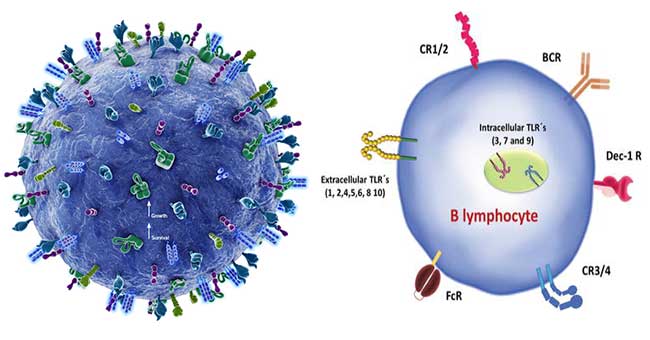B lymphocytes, the cells that produce antibodies, were so called because in birds they were found to mature in an organ called the Bursa of Fabricius. In mammals, no anatomic equivalent of the bursa exists, and the early stages of B cell maturation occur in the bone marrow. Thus, B lymphocytes now refer to bone marrow–derived lymphocytes.

B cells are found in the germinal centers of the lymph nodes, in the white pulp of the spleen, and in the MALT. B cells perform two important functions:
- They differentiate into plasma cells and produce antibodies.
- They can present antigen to helper T cells (Act as Antigen Presenting Cells).
The major subsets of B cells are follicular B cells, marginal zone B cells, and B-1 cells, each of which is found in distinct anatomic locations within lymphoid tissues. Follicular B cells express highly diverse, clonally distributed sets of antibodies that serve as cell surface antigen receptors and as the key secreted effector molecules of adaptive humoral immunity. In contrast, B-1 and marginal-zone B cells produce antibodies with very limited diversity.
Interesting Science Videos
Origin of B cells
B-cell development begins in the bone marrow with the asymmetric division of an HSC and continues through a series of progressively more differentiated progenitor stages to the production of common lymphoid progenitors (CLPs), which can give rise to either B cells or T cells. Progenitor cells that remain in the bone marrow become B cells. B cell precursors, during embryogenesis, first proliferate and develop in the fetal liver. From there, they migrate to the bone marrow, the main site of B-cell maturation in the adults. The Pre-B cells have only µ heavy chains in the cytoplasm but do not have surface immunoglobulin and light chains. Pre-B cells are found in the bone marrow, while mature B cells are found in the circulation.
According to clonal selection theory, each immunologically competent B cell possesses receptor for either IgM or IgD that can combine with one antigen or closely related antigens. After binding of the antigen, the B cell is activated to proliferate and form a clone of cells. Selected B cells are transformed to plasma cells that secrete antibodies specific for the antigen. Plasma cells synthesize the immunoglobulin with the same antigenic specificity as those carried by activated B cells.
B cells mature in two phases:
- Antigen-independent phase, which consists of stem cells and pre-B cells
- Antigen-dependent phase, which consists of the cells, such as activated B cells and plasma cells that proliferate on interactions of antigen with B cells.
B cells possess surface IgM, which acts as a receptor for antigen. Some B cells may also carry on their surface IgD as receptor for the antigen. There are many other molecules expressed on the surface of the B cells, which serve different functions. A few of them are B220, class II MHC molecules, CR1 and CR2, CD40, etc.
Activation of B cells
Activation of B cells to produce the full range of antibodies first requires recognition of the epitope by the T-cell-antigen receptor and the production of IL-4 and IL-5 by the helper T cells. In addition, it also requires other co-stimulatory interactions of CD28 on the T cells with B7 on the B cells. The CD28–B7 interaction is essential to produce IL-2. It also includes CD40L on the T cells, which must interact with CD40 on the B cells. The CD40L–CD40 interaction is essential for class switching from IgM to IgG and for switching between other immunoglobulin classes to take place.
Effector functions of B cells
Production of many plasma cells is the end result of activation of B cells. The plasma cells in turn produce large amounts of immunoglobulins specific for the epitope of the antigen. Some activated B cells also produce memory cells, which remain in a stage of quiescence for months or years. Most memory B cells have surface IgG that acts as the antigen receptor, but some even have surface IgM. These quiescent memory cells are activated rapidly on re-exposure to antigen. Memory T cells produce interleukins that facilitate antibody production by the memory B cells. The presence of these cells is responsible for the rapid appearance of antibody in the secondary immune responses.
B-cells respond to two different types of antigen
- Thymus-independent antigens are polymeric molecules which cross-link many specific Ig receptors and provide a persistent signal to the B-cell.
- Thymus-dependent antigens require the co-operation of helper T-cells to stimulate antibody production by B-cells. Antigen captured by specific Ig receptors is taken into the B-cell, processed, and expressed on the surface as a peptide in association with MHC II. This complex is recognized by the T-helper cell, which activates the resting B-cell.
